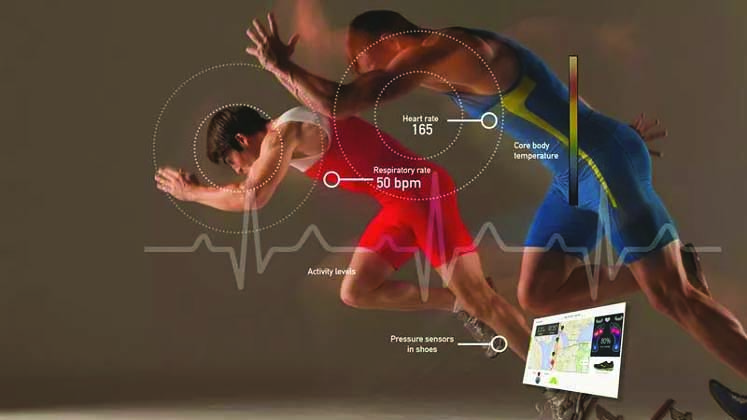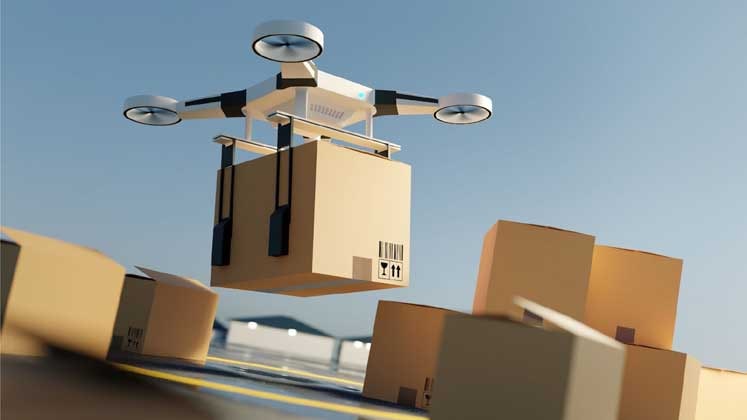The fashion industry is on the cusp of a major transformation and will continue to do so in the next 10 years. While all through 2022, retailers talked about metaverse and NFT and even brands came forward to experiment with the idea, 2023 certainly seems promising in terms of deployment strategies, new concepts and innovations in the older ones. The technological shift will include new applications throughout the value chain, from design and manufacturing to marketing and sales.
Team FTJ has prepared top 10 tech trends that will leave great impacts on the fashion industry in 2023 and beyond.
Fashion companies invested between 1.6 and 1.8 percent of their revenues in technology. By 2030, that figure is expected to rise between 3.0 and 3.5 percent.
1. Metaverse will be the universe of fashion opportunities
(Trend in MarTech)
The ‘metaverse’ is a digital realm built on a single interconnected ecosystem and will allow digital fashion opportunities in the industry. By next year, there will most likely be many metaverse platforms with their own economies and the capacity to transport assets and objects between the metaverse and one’s own world. Additionally, the enterprises will incorporate reality into the metaverse, going beyond virtual showrooms. The metaverse concept is predicted to expand dramatically, impacting all corporate activities, gaming industry as well as the real estate world.
If Web1 was about ‘read’ and Web2 was about ‘read and write’, then Web3 or Web 3.0 is about ‘read, write and own’ which will be the facilitator.
The next phase is to build a full 3D metaverse that is more immersive and lifelike and this is where Web 3.0 enters the picture. Web 3.0 will enable the establishment of a decentralised environment for metaverse by using the potential of blockchain technology. This will allow anyone to construct their own 3D world that others can visit and explore. Within it, virtual reality shopping malls, sports complexes and even entire cities will be developed.
Web 3.0 has the potential to revolutionise the fashion industry as this third version of the internet gives people more control over their data. Additionally, smart contracts and blockchain-based applications will allow for more customisation and personalisation of fashion items.
Similar to search engines and social networks that actively contributed to the growth of Web 1.0 and 2.0, marketing-driven advertising has the potential to hasten the mainstream adoption of Web 3.0 and metaverse.
The model is gaining the trust of the industries and there are already many firms participating in the virtual world through Web 3.0, including major worldwide financial sector leaders such as J.P. Morgan and fashion retailers like Gucci, Zara, Lacoste and Nike. A certain trend to watch out for!
The global Web 3.0 blockchain market accounted for US $ 1.2 billion in 2020 and is estimated to be US $ 87.7 billion by 2030 and is anticipated to register a Compound Annual Growth Rate (CAGR) of 45.20 per cent.
Solution Providers
- MetaBharat
- Trace Network
- Daz3D Studio
- Webbi3
- WazirX
2. B2B and B2C digital marketplaces will shape powerful fashion supply chains
(Trend in Retail Tech and Manufacturing Tech)
B2B and B2C Marketplaces are emerging fast in the fashion business landscape and they’re enabling pathways for retailers and address many important issues that plague supply chains, from product development to merchandise allocation and planning. They represent much greater potential value than merely reducing purchasing costs through aggregation.
All through 2021 and 2022, B2B Marketplaces created a buzz in the fashion industry, onboarding a number of factories and brands on digital platforms; however, understanding of such a concept is still in the nascent stage. And, the same goes for B2C Marketplaces which are about to become a US $ 7 trillion industry worldwide by 2030.
B2B Marketplaces, when aligned with technology, give brands a one-stop online dashboard for all their apparel procurement needs. Brands can upload designs, get quotations, review supplier certifications and source hassle-free due to technology integration, a faster turnaround time, adoption of lower MOQ as well as reduced inefficient communication and process bottlenecks.
As we are rapidly approaching 2023, B2B Marketplaces can assist the fashion industry in overall increased coordination amongst buyers and suppliers, eliminate or reduce delays in critical steps in the supply chain, decrease the need for unplanned airfreight shipments and, ultimately, fewer markdowns. Improving information flow permits retailers and suppliers to better monitor the flow of goods through logistics systems. All this leads to increased revenue for retailers as well as suppliers.
Some B2B and B2C Marketplaces work like business facilitators instead of aggregators and partner with different stakeholders to provide the consumer with the best support. This is a sure trend to look out for in 2023!
75 per cent of B2B purchases are taking place online, so there is a strong need for a solid online presence. These platforms also enable to capitalise on existing buyer demand to expand the customer base nationally as well as globally.
Solution Providers
- Geniemode
- ReshaMandi
- uKom
- Seamless Source
- Udaan
- IndiaMart
- Zalora
- Fashinza
- Merchant Bay, Zilingo
- Moglix Fashion
- Groyyo
- Yarn Bazar
- Amazon
- Alibaba
- Flipkart
- AJIO and Myntra
3. Immersive technology to be the best bet for the fashion industry
(Trend in Retail Tech)
The future of technology in our digital lives will be social interactions taking place in online virtual world where people will live, play and work. As per reports, the immersive market will be worth about US $ 333 billion by 2025. Following the introduction of VR (Virtual Reality), AR (Augmented Reality), and MR (Mixed Reality), XR (Extended Reality) will now act as a supporting technology that overlays existing features. Extended Reality (XR) is a relatively new technology that is gaining traction in the commercial arena and includes both AR and VR. It refers to any technology that can create an immersive digital environment mimics real-world scenarios or enhance existing ones.
VR and AR (as well as its combination XR) are increasingly being used by companies for internal fashion business and marketing. Some companies are incorporating AR into their manufacturing processes as well as in their retail operations to engage customers like digitally trying on garments without having to enter a fitting room.
Whereas VR can be used for fashion runway shows and other events that need presence of digital models. Designers can use it to create a virtual environment that allows viewers to experience their creations in a whole new way. And with XR, such an environment can be made even more realistic and lifelike. With the fashion industry being one of the most promising applications of XR, the trend is going to catch up in 2023 and make a drastic impact on how shoppers buy.
Additionally, the price of the required hardware such as HMDs and smart glasses will drop substantially, which is one of the primary reasons that will hasten the adoption of augmented reality technology in general. Moreover, enhancements to augmented reality software will improve the user experience and make it easier to operate, thereby increasing its popularity.
Also, a number of fashion designers and apparel companies are now using 3D virtual sampling as increasing demand has caused them to become more flexible and use technology to bring new products to market much faster.
Since physical prototypes are now no longer needed, factories can experiment with many more designs than before, resulting in better product quality. So, 3D virtual simulation is having a huge impact on the apparel industry, making it more efficient and productive than ever before. Not just product development, 3D helps fashion become more sustainable too which is already accused of being one of the most polluting industries in the world. In this way, manufacturers can save time and money by optimising their processes before actually producing the garments.
Though 3D has been there for years, the acceleration has been witnessed only after the pandemic. 2021 and 2022 became two important years when a good number of factories adopted 3D simulation software and the trend will get even more attention in 2023 as brands are now asking factories to go for 3D sampling. This transformation will present challenges and opportunities for both retailers and manufacturers.
It’s predicted that the global virtual fitting room market will grow from US $ 3 million in 2019 to US $ 6.5 million by 2025. That’s a compound annual growth rate of 13.44 per cent!
The immersive market is set to be worth about US $ 333 billion in three years
Solution Providers
- Stylumia
- LFX
- QArt Fashion
- BigThinx
- Sprint AI
- GMetriXR
3D Solution Providers:
- Tukatech
- Lectra/Gerber
- Clo3D, Browzwear
- 3DLOOK, LFX
- z-Emotion
- Assyst GmbH
- Optitex
- TG3D Studio
4. Digitisation in fashion
(Trend in Retail Tech and Manufacturing Tech)
‘Digital Twin’ for apparel industry is no fancy approach. Every factory wants to – (1) reduce defect rate in the garment products; (2) reduce production costs; (3) see the processes on shopfloor take place without manipulation and are effectively tracked in real-time; (4) increase speed to market; (5) see their equipment and machinery last long; and (6) devise a strategy that can lead them to long-term business sustainability. With Digital Twin, all these expectations are achievable.
The concept allows factories the convergence of the virtual world with the physical world and that means they can create a near real-time digital image of a physical object or even a process to avoid any shortcomings before it even occurs. Moreover, not just ‘Conceptualisation’, Digital Twin’s functions also work predominantly on ‘Comparison’ and ‘Collaboration’. Conceptualise product info, compare virtual with real and collaborate to make relevant changes in the real system!
In addition, digital twins can be used to monitor consumer behaviour and preferences in order to tailor products and experiences. Due to the rise of Digital Twins, a hyper-automation trend will influence the market in 2023.
The forecast for the digital twin market sees an astronomical figure of US $ 48.2 billion by just 2026 and growing at a compound annual growth rate of 58 per cent. The adoption of digital twins is a key ingredient for businesses to be future-ready.
Solution Providers
- Kinchit Technologies
- Pratiti Technologies
- SwitchOn
- E.ON
- Black Swan Textiles
5. Smart textile-based wearables
(Trend in Wearable Tech)
The manner in which we shop and engage with clothing is evolving. In the future, clothing will be interactive, connected and tailored to our individual preferences. This transition is being driven by technological breakthrough in smart textiles. Smart textiles are fabrics with embedded sensors, electronic components and other digital components. This enables them to collect data, communicate with other devices and respond to external stimuli. One of the most exciting applications of smart textiles is in the field of wearables.
Wearable devices are already becoming increasingly popular, but their potential will be transformative when they are built using smart textile concepts. In 2023, smart textile-based wearable devices will become a major trend in retail. These devices will offer a new level of convenience, comfort and customisation that cannot be matched by conventional clothes.
Smart textile is a material that has been designed to incorporate technology into its very structure. This indicates that it can be used to build interactive clothing and other objects with a variety of functionalities. Smart textile has the potential to revolutionise the way we purchase and interact with our apparel, and consumers do seem very much curious and interested to foray into the segment and anticipate the retailers to launch products for commercial use at an affordable range.
The possibilities are limitless and smart textiles will significantly alter the consumer experience. Additionally, the potential uses for smart textiles are vast and it is expected to have a major impact on the retail industry in the coming years.
For example, imagine being able to purchase a garment whose temperature automatically changes with your body temperature. During a run, for instance, if your smart shirt indicates that your heart rate is too high, you will know to slow down or take a rest. Or, if you are lost, your jacket might provide you with directions to your destination. This is just a gist of how smart textile-based wearables are going to change our lives in 2023. They’ll make people more connected, more informed and more efficient in everything they do.
Solution Providers
- AiQ Smart clothing,
- Xenoma
- CuteCircuit
- Myant
- Hexoskin
- Twinery-MAS innovations
- InQube
- Dhama innovations
According to Global Data forecast, the global smart clothing market worth US $ 668 million in 2020 will expand to over US $ 4 billion in the next 10 years. The segment has the potential to even cross the bill mark of US $ 30 billion by 2040 with the help of technologies such as embedded sensors, actuators or conductive fibres.
Solution Providers
- Cajoo
- Flink
- Bringo
- Shiprocket
- Deliveroo
- Instacart
- ninjacart
- homebase
- clickpost
- E-logistics
- Riddi corporate
- SMV green solutions
6. Micro Fulfilment Centres (MFCs) are supply chain’s latest efficiency booster
(Trend in Retail Tech)
As the popularity of e-commerce and online shopping increases, the number of micro fulfilment centres (MFCs) are also growing proportionally. It is not wrong to say that MFCs represent the ‘future of retail’. It is expected that by 2023, approximately 60 per cent of all fashion businesses will use MFCs in some form. Micro fulfilment centres offer numerous benefits that traditional warehouses cannot, including shorter delivery times, lower shipping costs and greater flexibility.
MFCs can enhance order accuracy rates because things are chosen and packaged with greater care when they are located closer to their final destination. They offer a much faster and more efficient method of order fulfilment. MFCs can utilise robotics and other innovative technologies to expedite the picking and packaging process, hence cutting order fulfilment times even further. This is crucial for fashion firms since customers increasingly expect quick delivery periods, and those who cannot match this demand will likely lose market share to the competitors.
In addition, brands can store a wider variety of products in their MFCs than in a traditional warehouse because there are no space constraints. This means customers will have better access to a wider range of products. Companies will also be better able to respond to changes in customer demand because they will be more flexible and able to quickly adjust their inventory levels.
Traditional warehouses are unable to keep up with ever-changing trends in the fashion industry, but MFCs can. This is especially important for fashion brands that often have time-sensitive orders.
MFCs also allow brands to store their goods closer to the end consumer, which is a significant advantage. This reduces shipping costs and delivery times, allowing for better customer service (for example, same-day delivery).
MFCs give brands greater control over their inventory and fulfilment process. With a traditional fulfilment centre, a brand has limited visibility and control over what actually happens. With MFCs, however, brands can track every stage of the process and make on-the-spot adjustments as needed
Also, with various tech-enabled solutions of Automated Storage and Retrieval System (ASRS), MFCs offer a number of benefits that prove advantageous to fashion brands looking to stay ahead of the competition by allowing them to quickly adapt to changes in demand and inventory levels.
Solution Providers
- WareIQ
- Codept
- Hormann
- Intralogistics
- AutoStore
7. Digital Currency: a way forward for doing business
(Trend in MarTech)
Reserve Bank of India (RBI) has recently launched e-rupee at a time when everybody else is talking just about cryptocurrencies, bitcoin etc. E-Rupee is digital money that can be transferred directly from a customer’s wallet to other wallet and they may not even require internet connection to make these transactions. Unlike UPI transfers, there won’t be any intermediaries (banks) in this case.
The transactions are right now open only for select group of people and are conducted through CBDC app (Central Bank Backed Digital Currency). With successful registrations on the app, one should be able to load any amount of money in their wallet and start transacting with other wallets. The bigger objective behind launching this digital rupee is to bring online transactions as close to physical money transactions and address two things: (1) Instant transactions of any denomination from one wallet to other; and (2) No waiting time like in banks to transfer money to newly added beneficiaries.
As the industries continue to globalise and become more competitive, digital currencies offer a way for businesses to transact without having to rely on traditional banking systems. Notably, digital money can also be used to speed up cross-border transactions and trade, which is crucial to the development of our global economy. This means that central banks will need to keep spending money on creating their own digital currencies. To guarantee that their currencies continue to be competitive, they will also need to be up-to-date with the most recent fashion and technological advancements.
There are a number of advantages that digital currencies offer over traditional fiat currencies. For one, they provide a more secure and efficient way to transact. With digital currencies, there is no need to worry about exchange rates or inflation; all transactions are completed directly between two parties, without any third-party involvement. Overall, digital currencies offer a number of benefits that make them well-suited for use in the fashion industry.
8. Advanced Manufacturing Execution System (MES)
(Trend in Manufacturing Tech)
An Advanced Manufacturing Executive System (MES) serves as the factory’s digital backbone, combining data from many sources and granting real-time production visibility. This lowers waste and boosts quality while enabling the fashion industry to react swiftly to shifts in consumer demand.
Additionally, an MES will provide visibility into inventory levels, allowing manufacturers to better manage their materials.
The fashion business, where trends can change quickly and product lifecycles are frequently brief, is a good fit for MES systems. MES systems can assist fashion businesses in keeping up with the newest trends and ensuring that their products satisfy the highest quality requirements by tracking every stage of the manufacturing process. The advantages of installing an MES system are obvious, but it can be a difficult and expensive task. An MES is a crucial tool for fashion businesses wanting to stay ahead of the competition.
It is said that manufacturing units are quite sluggish when it comes to integrating software solutions into the system. But the future seems bright with the transformational shift. The adoption of technology seems to be an added advantage for the manufacturers.
MES will be on the list of manufacturers as it helps to track and manage production data. In the fashion industry, an MES will be used to monitor the progress of garments through the manufacturing process, from cutting and sewing to final inspection. By tracking production data, an MES can help identify bottlenecks and inefficiencies in the manufacturing process.
With a plethora of advantages, MES as a trend is sure to pick up speed in 2023 certainly.
Solution Providers: Coats Digital, Zilingo Factory, STITCH MES, Jaza Software, Qapp, QIMA, Blue Kaktus
9. Recommerce will curb the throwaway culture and encourage sustainable practices
(Trend in Retail Tech)
The current economic climate signifies a fundamental shift in consumer behaviour for e-commerce companies. Consumers are less inclined to purchase ‘new’ products, instead, they are exploring the second-hand retail market and henceforth 2023 is going to be a big year for recommerce (the buying and selling of used goods). According to experts, this shift is driven by a number of factors, including the rising price of new products, the proliferation of online marketplaces and a growing awareness of the environmental impact of consumerism.
Additionally, three significant factors will drive the growth of recommerce: first will be the increasing availability of quality used goods – as consumer awareness of the benefits of recommerce increases, they are more willing to purchase used goods. This is especially true for luxury brands, whose superior craftsmanship allows used items to be sold close to the original price. Secondly, to catch up with the trend, many companies will launch better tech-enabled recommerce platforms for easy customer journey and transparency. The final driver of recommerce is a shift in consumer attitudes. Consumers are increasingly concerned about sustainability and the environment. They can reduce their carbon footprint and make a positive contribution to the environment by purchasing used goods. Additionally, many consumers view recommerce as a more moral form of shopping because it benefits local sellers. In 2023, recommerce will have a significant impact on the retail landscape. It will provide consumers with a more affordable and sustainable way to shop and will represent a significant growth opportunity for retailers.
Solution Providers
- Relove
- Kiabza
- Depop
- ThredUP
- Poshmark
- Rent the Runway
- TheRealReal
- Vestiaire Collective
- Cocoon
- Recommerce to grow close to US $ 245 billion by 2025- Statista
- 80 per cent of Generation Z and 78 per cent of millennials have purchased pre-owned products in the past 12 months
10. ONDC to disrupt the future of digital commerce
New apparel retailers in India are often faced with the challenges of accessing the benefits of digital commerce because of the monopoly of existing big retailers. Whether it is to capitalise on larger markets; engage customers in superficially rich e-commerce experiences that transcend borders; or find new ways to deliver compelling shopping experiences, new retailers are at a disadvantage of being shackled to old processes and digital infrastructure. To overcome these concerns, an initial idea by Piyush Goyal and led by 9 members of the advisory board, a new network model named Open Network for Digital Commerce (ONDC) was curated that promises to break through these constraints and gradually unleash the transformative power of digital commerce in India. Some key stakeholders such as SBI, HDFC Bank, Axis Bank, BSEI & NSEI, Quality Council of India have shown faith in the system, which would help by plugging in small traders and retailers and providing them wide reach with set protocol for cataloguing, vendor match and price discovery on an open-source basis.
ONDC is expected to digitise the entire value chain in the upcoming year, help standardise operations, drive logistical efficiency and, most importantly, curb the monopolies of the platform-centric model that leads to market concentration. It can be beneficial to new entrants because ONDC is not controlled or owned by a single identity and also helps improve the discoverability and accessibility of products across the platform, provides equal opportunities for small retailers, follows transparent practices and offers lower order acquisition costs. More and more companies have planned to join ONDC to provide customers with better service.
Companies such as Dunzo, Loadshare and Shiprocket offer logistics services. Protean eGov Technologies Ltd (formerly NSDL e-Gov) is behind the gateway services. NowFloats and Plotch are technology service providers, Kiko Live is the industry’s live video shopping platform and the e-commerce platform Snapdeal, which offers fashion and other services, will encourage buyers and sellers to join the ONDC network.
Solution Providers
- Craftsvilla
- CSC Grameen eStore
- Ekart
- Shopalyst
11. Autonomous Delivery Robots (ADR) and Drones to play major roles in the product delivery mechanisms
With the expansion of the customer base for online shopping, retailers are focusing upon on-time delivery of products. Many e-commerce platforms now provide same-day delivery. An ADR helps sellers and logistics providers avoid losses incurred due to last-mile delivery failures. The need for high efficiency in logistics and supply chains and pressure to control carbon emissions is expected to propel its growth in the upcoming year.
Various governments have enforced strict regulations to reduce carbon emissions. As a result, many companies are looking for alternatives, such as autonomous vehicles (AVs), for transportation. ADRs can deliver products to consumers at their convenience, which reduces the number of delivery re-attempts and the associated emission levels. Hence, ADRs help in reduced carbon emissions and are becoming a popular delivery alternative.
Chinese retailer JD.com operates fleets of 30 autonomous delivery vehicles, and Amazon’s scout delivery robots are becoming a common sight in US cities, including Irvine, California; Atlanta, Georgia and a few more cities.
Automating this step of the process not only increases efficiency by removing the need for expensive manual courier delivery for last-mile fulfilment, but it also enables businesses to minimise their carbon footprint because the vehicles are typically electric and can be powered by renewable source.
Additionally, it is anticipated that by 2023, drones would play a significant part in fashion product delivery systems and inventory management assistance as drones can deliver goods more quickly and efficiently than conventional delivery methods, such as by automobile or truck. In addition, drones are less likely to cause transit-related goods damage. Drones will be able to carry heavier payloads and travel farther as their technology advances. Moreover, the development of AI-enabled drones will boost the effectiveness of drone operations for fashion retailers.
For now, drones seem expensive and in the middle of a lot of restrictions in accordance with the FAA (Federal Aviation Administration) regulations and licensing, which restricts their broad use, but this will change in 2023 and beyond when they will become mainstream delivery methods. But seeing the quick approval being granted to companies across sectors by the governments in various countries, including India where it recently got approved for recording live cricket matches, the future of drones seems to be bright.
Secondly, in warehouse centres, drones sometimes may face visibility and navigation problems as the centres have diverse structural complexities, geographical locations and a variety of inventory items. However, improvements in computer vision integrated with neural networks can solve these visibility problems in drones of the future.
Since the pandemic, Starship Technologies’ delivery robots have been in high demand like never before and have now completed over 100,000 autonomous deliveries in the UK, USA and Europe.
Solution Providers
GridBots
DiFacto
Geek+
Amazon Scout
Locus Robotics
Eliport
Ottonomy


















